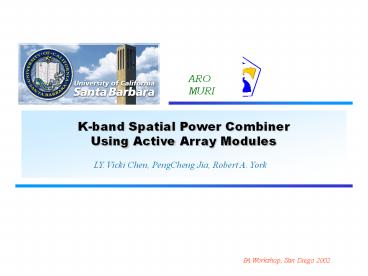ARO - PowerPoint PPT Presentation
Title:
ARO
Description:
Good heat-sinking property. Consuming more substrate area. ARO. MURI. System Overview ... Extended work from the X-Band Spatial Combiner Design ... – PowerPoint PPT presentation
Number of Views:266
Avg rating:3.0/5.0
Title: ARO
1
ARO MURI
K-band Spatial Power Combiner Using Active Array
Modules
LY. Vicki Chen, PengCheng Jia, Robert A. York
PA Workshop, San Diego 2002
2
ARO MURI
Presentation Outline
- Passive System
- Antenna array, Higher order mode problem,
Performance - Amplifier Design
- Two-stage Amplifier, Flip-Chip IC, CPW-line
- Power Combiner
- Design considerations, Performance
- Conclusions
3
Spatial Power Combining
ARO MURI
- Normal incident/outgoing waves
- Limited bandwidth in general
- Easier for monolithic design
- Challenge in thermal management
Tile Approach
- Parallel incident/outgoing waves
- Broadband characteristics
- Good heat-sinking property
- Consuming more substrate area
Tray Approach
4
System Overview
ARO MURI
- Extended work from the X-Band Spatial Combiner
Design - Oversized Waveguide Environment TE10, TE20 from
18 to 22GHz - Fin-line to CPW line Transition
- Monolithic Circuit Design Flip-Chip IC
Oversized waveguide (TE10,TE20)
Gradual transition from WR42 to the oversized
waveguide
Active Devices
Tapered-Finline Antennas
5
ARO MURI
Antenna Design
Finline to CPW line transitions
- Design is based on the optimal taper design of
the X-band system. - Finline to CPW line transitions Eliminate the
bond-wires. - Air-bridges are needed to provide good grounding
in the middle ground plane. - Use HFSS for simulation.
Klopfenstein Taper
Ground
Signal
Ground
Signal
Ground
CPW line
AlN substrate
Reference paper Design of Waveguide Finline
Arrays for Spatial Combining. Submitted to IEEE
transaction on MTTs
6
ARO MURI
HFSS Simulation
By forcing the PMC boundary condition, the even
mode does not exist in the system.
PEC
PEC
metal
air
Et
Et
metal
PEC
Fin-line
Metal
PMC
PMC
Dielectric
- Simulate for 2x4 system.
- Simplify the problem by applying the boundary
conditions. - Impedance Gamma vs. Gap-size
- Finline CPW Transition
- Reflection coefficient for the taper design.
Et
Waveguide Wall
7
Effects of Mounting Grooves
ARO MURI
Single mode unilateral finline
The mounting grooves affect the optimal values of
many parameters
d
- Operating frequency
- Effective dielectric constant
- Substrate thickness
b
Small slots are affected more severely than
broader slots.
Reflection Coefficient (dB)
short circuit grooves
The depth of the short circuit grooves has huge
effect on the return loss
d?/5 d2?/15
d
8
Combining Efficiency
ARO MURI
- Symmetrical loading is necessary to avoid TE20
mode and achieve efficient combining. - 76 combining efficiency is achieved.
6 cards (4x6 system) 50ohm Termination
Through-line measurement
Measurement for one card (asymmetrical) and two
cards (symmetrical) system
Frequency (GHz)
Frequency (GHz)
9
Two-Stage Amplifier Design Flip-Chip Technology
using CPW-line
ARO MURI
- Thermal Management FCIC
- Gain Enhancement pre-amplifier
- Optimal load matching
- ADS/Momentum Simulations
Power device
Pre-amp
- Design Challenges
- Substrate modes are excited easily.
- Biasing circuitry is complicated.
- Good grounding should be maintained.
13.5mm
Ground
Signal
8.56mm
Ground
Signal
Ground
10
Two-Stage Amplifier Design CPW-line Substrate Mode
ARO MURI
Substrate mode is excited easily!
Increasing the substrate thickness or reducing
the width of the CPW-line could reduce the effect
of the substrate mode.
?AlN gt ?eff gt ?Air
?eff
?AlN
Quasi-TEM
S21(dB) of the Two-stage Amplifier
11
Two-Stage Amplifier Performance
ARO MURI
- Return loss lt-10dB for the operating frequencies.
- 27.3dBm output power with 20 PAE and 9.5dB power
gain was obtained. - Thin film (on-chip) and chip capacitors were both
needed for biasing circuitry.
Pout
PAE
Gain
12
Combiner Performance Two Cards Measurement
ARO MURI
- Small Signal Performance Power Measurement _at_
18GHz - Two cards system (8 amplifiers) with 34dBm output
power. - 12.5 PAE 62 Combining Efficiency (optimal
76) - Phase difference between cards degrades the
output performance the most.
Pout (dBm)
PAE
Gain (dB)
13
Measurement
ARO MURI
14
Statistical Errors in Arrays
ARO MURI
Output voltage
G1
Bout
A
G2
Splitter
Combiner
Probability of device survival
ri 0 or 1
GN
Output Power
Change in power due to errors
Ensemble average
Phase errors and device failures are most
important in large combiners
Ref R. York, Some considerations for Optimal
Efficiency and Low Noise in Large Power
Combiners, IEEE Trans. Microwave Theory Tech.
15
Combiner Performance 6 Cards Measurement
ARO MURI
- Six Cards System (6x4) 2 devices failed.
- 10dB small signal gain.
- Absorbing material were added to prevent the
in-band oscillations. - Each cards was biased individually.
- Improper grounding could result in oscillations.
- Some chip resistors were added to prevent
bias-line oscillations.
Signal cross-talk between bond-wires could induce
in-band oscillations
Absorbing Material
16
Phase Noise Reduction
ARO MURI
G
Amplifiers degrade phase noise due to internal
nonlineariities which up convert low-frequency
amplitude and phase noise to the carrier
G
Splitter
Combiner
G
Noise contributed by the ensemble is reduced by
1/N (-13.4dB) compared with a single amplifier
17
Power Measurement
ARO MURI
Non-uniform excitation profile
- 37.3dBm output power _at_18GHz was obtained.
- Non-uniform excitation.
- Chip resistors were added for bias-line
stabilization. - Combining Efficiency 53.7.
18
Conclusion
ARO MURI
- Passive combiner achieved 76 combining
efficiency. - 34dBm output power has been obtained for 2-tray
system. - 62 combining efficiency was obtained.
- 37.3dBm output power has been obtained for 6-tray
system. - 53.7 combining efficiency was obtained.
- Phase noise reduction compared with single
amplifier. - Stabilization should be maintained for all
frequencies.































